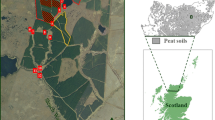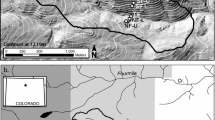Summary
Studies were conducted with coniferous forest floor microcosms to examine the potential influence of acid precipitation, temperature changes, and plant uptake upon the chemistry of soil leachate solutions. The experimental design included two temperatures and three different simulated throughfall chemistry treatments. When the acidity of throughfall inputs to the microscosms increased, the forest floors exhibited increased leaching losses of calcium, magensium, potassium, and ammonium. The fact that aluminum losses did not incrase correspondingly suggested that there may be a kinetic lag in the mobilization and leaching of aluminum. When microcosms were exposed to warmer temperatures, percolates showed increased leaching losses of calcium, potassium, ammonium, sulfate, nitrate, and organic anions. Forest floor microcosms exposed to simulated average field conditions behaved very much like field plots under the same environmental conditions; however, there were predictable differences in leaching losses between laboratory and field systems for those ions which are strongly controlled by plant uptake. In general, the exclusion of plant uptake from microcosms resulted in increased leaching of potassium, nitrate, ammonium. and sulfate relative to field plots.
Similar content being viewed by others
References
Abrahamsen, G., Bjor, K., Horntvedt, R. and Tveite, B. 1976 Effects of acid precipitation on coniferous forest.In Impact of Acid Precipitation on Forest and Freshwater Ecosystems in Norway. Ed. F. H. Braekke. pp. 38–63. SNSF-project, Aas-NLH, Norway.
Berthelin, J., Kogblevi, A. and Dommergues, Y. 1974 Microbial weathering of a brown forest soil: influence of partial sterilization. Soil Biol. Biochem.6, 393–399.
Cole, D. W. and Johnson, D. W. 1977 Atmospheric sulfate additions and cation leaching in a Douglas fir ecosystem. Water Resour. Research13, 313–317.
Cronan, C. S. 1978 Solution chemistry of a New Hampshire subalpine ecosystem: biogeochemical patterns and processes. Ph. D. thesis, Dartmouth College.
Cronan, C. S. 1978 A soil column tension lysimeter that minimizes experimental edge effects. Soil Sci.125, 306–309.
Cronan, C. S., Reiners, W. A., Reynolds, R. C. and Lang, G. E. 1978 Forest floor leaching: contributions from mineral, organic, and carbonic acids in New Hampshire subalpine forests. Science200, 309–311.
Cronan, C. S. 1980 Solution chemistry of a New Hampshire subalpine ecosystem: a biogeochemical analysis. Oikos34, 212–281.
Dougan, W. K. and Wilson, a. I. 1974 The absorbtiometric determination of aluminum in water. A comparison of some chromogenic reagents and the development of an improved method. Analyst99, 413–430.
Feller, M. C. 1977 Nutrient movement through western hemlock-western red cedar ecosystems in southwestern British Columbia. Ecology58, 1269–1283.
Johnson, D. W. and Cole, D. W. 1977 Sulfate mobility in an outwash soil in western Washington. Water, Air, Soil Pollut.7, 498–495.
McColl, J. G. 1973 Environmental factors influencing ion transport in a Douglas fir forest soil in western Washington. J. Ecol.61, 71–83.
Overrein, L. N. 1972 Sulfur pollution patterns observed: leaching of calcium in forest soil determined. Ambio1, 145–147.
Purchase, B. S. 1974 Evaluation of the claim that grass root exudates inhibit nitrification. Plant and Soil41, 527–539.
Rains, D. W. and Bledsoe, C. S. 1976 The effect of Douglas fir seedlings on the transfer of nutrients through soil columns. Plant and Soil44, 97–112.
Reiners, W. A. and Lang, G. E. 1979 Vegetational patterns and processes in the balsam fir zone, White Mountains, New Hampshire. Ecology60, 403–417.
Soil Survey Staff. Soil Taxonomy 1975 Agricultural Handbook No.436. Soil Conservation Service, USDA, 754 p.
Sokal, R. R. and Rohlf, F. J. 1969 Biometry. W. H. Freeman and Co., San Francisco. 776 p.
Vitousek, P. M. and Reiners, W. A. 1975 Ecosystem succession and nutrient retention: a hypothesis. Biosci.25, 376–381.
Vitousek, P. M., Gosz, J. R., Grier, C. C., Mellilo, J. M., Reiners, W. A., and Todd, R. L. 1979 Nitrate losses from disturbed ecosystems. Science204, 469–474.
Wiklander, L. 1973/74 The acidification of soil by acid precipitation. Grunnforbattring26, 155–164.
Wiklander, L. 1975 The role of neutral salts in ion exchange between precipitation and soil. Geoderma14, 93–105.
Wood, T. and Bormann, F. H. 1976 Short-term effects of a simulated acid rain upon the growth and nutrient relations ofPinus strobus, L.In Proceedings of the First International Symposium on Acid Precipitation and the Forest Ecosystem. Eds. L. S. Dochinger and T. A. Seliga. pp 815–827. Northeast Forest Experiment Station. USDA Forest Service General Technical Report NE-23.
Author information
Authors and Affiliations
Rights and permissions
About this article
Cite this article
Cronan, C.S. Controls on leaching from coniferous forest floor microcosms. Plant Soil 56, 301–322 (1980). https://doi.org/10.1007/BF02205859
Received:
Issue Date:
DOI: https://doi.org/10.1007/BF02205859




